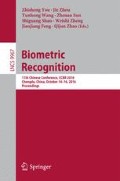Abstract
Iris recognition is a reliable method to protect the security of mobile devices. Low resolution (LR) iris images are inevitably acquired by mobile devices, which makes mobile iris recognition very challenging. This paper adopts two pixel level super-resolution (SR) methods: Super-Resolution Convolutional Neural Networks (SRCNN) and Super-Resolution Forests (SRF). The SR methods are conducted on the normalized iris images to recover more iris texture. Ordinal measures (OMs) are applied to extract robust iris features and the Hamming distance is used to calculate the matching score. Experiments are performed on two mobile iris databases. Results show that the pixel level SR technology has limited effectiveness in improving the iris recognition accuracy. The SRCNN and SRF methods get comparable recognition results. The SRF method is much faster at both the training and testing stage.
Access this chapter
Tax calculation will be finalised at checkout
Purchases are for personal use only
References
Timofte, R., De Smet, V., Van Gool, L.: Anchored neighborhood regression for fast example-based super-resolution. In: Proceedings of the IEEE International Conference on Computer Vision, pp. 1920–1927 (2013)
Huang, J., Ma, L., Tan, T., Wang, Y.: Learning based resolution enhancement of iris images. In: BMVC, pp. 1–10 (2003)
Nguyen, K., Fookes, C., Sridharan, S., Denman, S.: Feature-domain super-resolution for iris recognition. Comput. Vis. Image Underst. 117(10), 1526–1535 (2013)
Liu, J., Sun, Z., Tan, T.: Code-level information fusion of low-resolution iris image sequences for personal identification at a distance. In: IEEE Sixth International Conference on Biometrics: Theory, Applications and Systems, pp. 1–6 (2013)
Liu, J., Sun, Z., Tan, T.: Distance metric learning for recognizing low-resolution iris images. Neurocomputing 144, 484–492 (2014)
Dong, C., Loy, C.C., He, K., Tang, X.: Learning a deep convolutional network for image super-resolution. In: Fleet, D., Pajdla, T., Schiele, B., Tuytelaars, T. (eds.) ECCV 2014, Part IV. LNCS, vol. 8692, pp. 184–199. Springer, Heidelberg (2014). doi:10.1007/978-3-319-10593-2_13
Schulter, S., Leistner, C., Bischof, H.: Fast and accurate image upscaling with super-resolution forests. In: Proceedings of the IEEE Conference on Computer Vision and Pattern Recognition, pp. 3791–3799 (2015)
Sun, Z., Tan, T.: Ordinal measures for iris recognition. IEEE Trans. Pattern Anal. Mach. Intell. 31(12), 2211–2226 (2009)
Viola, P., Jones, M.J.: Robust real-time face detection. Int. J. Comput. Vis. 57(2), 137–154 (2004)
He, Z., Tan, T., Sun, Z., Qiu, X.: Toward accurate and fast iris segmentation for iris biometrics. IEEE Trans. Pattern Anal. Mach. Intell. 31(9), 1670–1684 (2009)
Daugman, J.G.: How iris recognition works. IEEE Trans. Circuits Syst. Video Technol. 14(1), 21–30 (2004)
Wang, L., Sun, Z., Tan, T.: Robust regularized feature selection for iris recognition via linear programming. In: International Conference on Pattern Recognition, pp. 3358–3361 (2012)
He, Z., Sun, Z., Tan, T., Qiu, X., Zhong, C., Dong, W.: Boosting ordinal features for accurate and fast iris recognition. In: IEEE Conference on Computer Vision and Pattern Recognition, pp. 1–8 (2008)
Zhang, Q., Li, H., Zhang, M., He, Z., Sun, Z., Tan, T.: Fusion of face and iris biometrics on mobile devices using near-infrared images. In: Yang, J., et al. (eds.) CCBR 2015. LNCS, vol. 9428, pp. 569–578. Springer, Switzerland (2015). doi:10.1007/978-3-319-25417-3_67
Zhang, Q., Li, H., Sun, Z., He, Z., Tan, T.: Exploring complementary features for iris recognition on mobile devices. In: International Conference on Biometrics (2016, to appear)
Acknowledgments
This work is supported by the National Natural Science Foundation of China (Grant No. 61403389), the Beijing Nova Programme (Grant No. Z141101-001814090), and the Beijing Talents Fund (Grant No. 2015000021223ZK30).
Author information
Authors and Affiliations
Corresponding author
Editor information
Editors and Affiliations
Rights and permissions
Copyright information
© 2016 Springer International Publishing AG
About this paper
Cite this paper
Zhang, Q., Li, H., He, Z., Sun, Z. (2016). Image Super-Resolution for Mobile Iris Recognition. In: You, Z., et al. Biometric Recognition. CCBR 2016. Lecture Notes in Computer Science(), vol 9967. Springer, Cham. https://doi.org/10.1007/978-3-319-46654-5_44
Download citation
DOI: https://doi.org/10.1007/978-3-319-46654-5_44
Published:
Publisher Name: Springer, Cham
Print ISBN: 978-3-319-46653-8
Online ISBN: 978-3-319-46654-5
eBook Packages: Computer ScienceComputer Science (R0)

